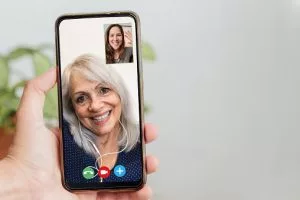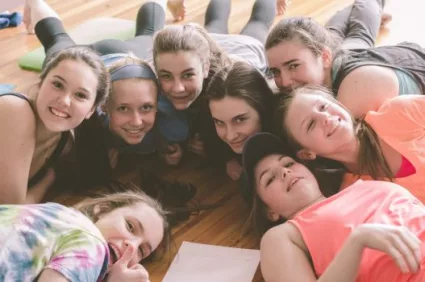
Have you ever been on a Zoom call with a donor and realized that that strange pinkish blob you were looking at was the inside of someone’s ear?
You may have looked at it for a while and not been able to make sense of it. But, if the person you were talking to was old-ish, you may not have wanted to upset her by asking. And then, suddenly, you made sense of what you were seeing and why.
Your donor was Zooming with you on her cell phone. And she hadn’t adapted from telephone practices to Zoom and was holding the phone up to her ear, just like the old days. That’s a donor you probably don’t want to solicit over Zoom.
But don’t automatically decide that you can’t use Zoom to ask older donors for their gifts.
Many older people are now quite savvy when it comes to Zoom. And particularly amid the pandemic, most of them are cautious about in-person meetings. They may prefer to meet with you on Zoom, both now and going forward.

To figure out who to solicit using Zoom and who to meet with in person, the answer is simple. Ask your donor which they would prefer! Chances are good that if you ask them a direct question, they’ll tell you what works best for them. This level of personalized attention is essential for effective fundraising, particularly during the quiet phases of large-scale campaigns.
But be prepared in case they say “Why don’t you just send me the material. There’s no need to meet.”
Asking for a larger gift over Zoom and in-person are both personal and conversational. But sending them a pledge form is not (although these do work well in other fundraising contexts). Even a simple phone call would be better than sending an impersonal document with no room for discussion or questions. So, if a donor declines meeting one-on-one, you’ve got to be ready to respond.
3 Things You Can Say to Get a Personal Meeting
1- State an authentic personal desire to meet.
Try something like, “I haven’t seen you in a long time and have been looking forward to getting together in person.”
2- Create a context for meeting in person.
Let the donor know that you are making it a point of meeting one-on-one with 20 (or whatever the number) of your top contributors this year.
3- Remember Feel, Felt, Found.
One tried and true approach for overcoming objections is the Feel, Felt, Found model. Tell the donor that you understand how she feels. Let her know that others have felt the same way, but that you’ve found that meeting face-to-face is often more satisfying for everyone.
Next, Determine Whether You’ll Meet In-Person or over Zoom

Once you have an indication that your donor is willing to meet face-to-face, then you should determine how you will meet. The simplest strategy is to ask for the donor’s preference. You’ll find that some people would much rather meet in person while others would much rather meet over Zoom.
The approach should reflect the preference of your donor.
Both in-person and Zoom meetings can work well. But there are some differences. Here’s what
we have found.
When You Solicit Donors Over Zoom, Avoid these Pitfalls:
Avoid Technical Problems
Often people have trouble with their audio during Zoom calls. Either the audio doesn’t connect, there’s lots of background noise, or they forget to unmute themselves. If you’ve hosted any large-scale virtual events recently, you likely know these problems all too well. These can be frustrating in both event and one-on-one contexts alike, and that doesn’t set up a good mindset for asking.
Ask the donor to schedule the call when they will be in a place where the internet connection is stable and there is not likely to be a great deal of background noise. You can be quite direct about that.
If when you get on the call, and it turns out that your donor is driving or in some public place where there is a great deal of distraction, ask to reschedule for another time when they can be at home.
Plan Shorter Meetings
Zoom meetings are usually shorter. You will have less opportunity for a general catch-up and
small talk. So, plan on 30 minutes rather than 45 minutes or an hour. Keep your goals focused—walking through your campaign’s case for support, fielding questions and feedback, and making the ask—without too much unnecessary small talk.
Use On-Screen Materials Judiciously
Use materials in a very limited way. When you share your screen in a Zoom meeting, the direct contact between you and the donor is greatly reduced. If you have materials you would like to direct the donor to, send hard copies beforehand. That way you can refer to them without
losing screen contact.
If you do share your screen, remember to stop sharing your screen as soon as the materials you are showing aren’t relevant anymore. That way you will maximize the time you are speaking directly to one another.
Limit the Number of People on a Zoom Solicitation
Resist the temptation to have more than one or two people from your side on the Zoom call.
It can be hard to read people on Zoom, as you don’t see much of the body language that is present in an in-person meeting. A Zoom meeting with only the solicitor and the donor increases your ability to focus on the donor’s attitude and subtle cues. But when you have more people on the call, you will lose much of the nuance.
3 Tips for Asking for Gifts in Either Format: In-Person or over Zoom
1- Clarify your intent before the meeting.
Don’t surprise your donors with an ask. Let the donor know that you would like to meet to ask them for a gift. If they decline the meeting because they don’t want to make a gift, it’s better that they do that early so you don’t waste your time or theirs.
2- Simplify the materials you use in the meeting.
Don’t use lengthy or complex materials during the meeting. Send materials before and/or after the meeting, but resist the temptation to review campaign brochures or lengthy documents during the meeting. If you use a slide deck during the meeting, make sure that each slide has only a few words.
3- Prepare questions to ask the donor.
Spend more time preparing questions to ask your donors than simply memorizing a “pitch.”
Remember that donors talk themselves into making a gift. Your job is to prompt them with questions so that they articulate why the project is important to them. Your actual presentation and ask should be a very small part of the solicitation meeting.

Zoom or In-Person Meetings – what’s the final verdict? It doesn’t matter much as long as it’s what the donor prefers. If you do a good job, either format will work well.
Toolkit Talks: Fundraising in Times of Crisis
Amy Eisenstein, ACFRE, and Andrea Kihlstedt are co-founders of the Capital Campaign Toolkit, a virtual support system for nonprofit leaders running successful campaigns. The Toolkit provides all the tools, templates, and guidance you need — without breaking the bank. Join Amy and Andrea in real-time every Monday as they discuss how to move forward with your fundraising efforts during uncertain times. These talks are open to everyone. Sign up and join the conversation!

Guest Author – Amy Eisenstein, ACFRE, is CEO & Co-Founder of the Capital Campaign Toolkit. She is a veteran fundraising consultant. With over 20 years of experience in the nonprofit sector, she’s published a number of books, including Major Gift Fundraising for Small Shops. Amy is also an in-demand keynote speaker and an engaging board retreat trainer and facilitator.



